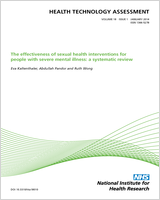Included under terms of UK Non-commercial Government License.
NCBI Bookshelf. A service of the National Library of Medicine, National Institutes of Health.
Hind D, Parkin J, Whitworth V, et al. Aquatic therapy for children with Duchenne muscular dystrophy: a pilot feasibility randomised controlled trial and mixed-methods process evaluation. Southampton (UK): NIHR Journals Library; 2017 May. (Health Technology Assessment, No. 21.27.)

Aquatic therapy for children with Duchenne muscular dystrophy: a pilot feasibility randomised controlled trial and mixed-methods process evaluation.
Show detailsConvergence assessment
The convergence between quantitative and qualitative findings is presented in Table 27. There was agreement on six components, silence on eight (all expected areas amenable only to qualitative assessment) and dissonance on two. The areas of dissonance concerned attendance and optimisation. In each case, simple reading of the quantitative data might lead to an overly simplistic attribution of cause. In the case of session attendance, most of the quantitative data pointed to illness or simple non-appearance of the family; the qualitative data revealed that the convenience of available time slots had a strong role in non-attendance for some families (see Chapter 5, Balancing the demands of the programme with work, school and family life). Similarly, the quantitative study identified an apparent failure to optimise the intervention on the part of several physiotherapists (see Table 23); the qualitative data revealed this to be part of a misunderstanding, with therapists wrongly assuming that the study required them to apply the manual prescriptively or extensively (see Chapter 5, Sense-making), rather than in the focused and more achievable way proposed at training (see Chapter 2, Interventions). The same therapists were aware and very concerned that therapy was not optimised.
TABLE 27
Convergence coding matrix for programme theory elements
Completeness assessment
Qualitative research contributed information to 15 out of 17 logic model components, whereas the quantitative components contributed to nine. This was expected; some components were not amenable to investigation in quantitative terms.
Summary
Figure 25 provides a summary of key points relating to the intervention implementation. Although families are motivated to access AT, the distance from tertiary centres precludes many and adds to the existing burden of disease management for those who engage. Pool availability is at a premium, not constant and often at inconvenient times. Tertiary centres were not committed to delivery at scale or beyond the life of the RCT, owing to the costs and opportunity costs being too great. Estimated direct NHS costs, based on a service at an acute trust, range from £1970 to £2734 over 6 months; this would compete poorly with other specialist paediatric services in terms of value for money, but the costs could be reduced considerably by delivery in the community. Specialist physiotherapists are motivated to help patients and most see a wider role for AT, but not with them or their NHS trusts as providers. The 1-day training course was well received. The AT manual provides a good basis for a flexible but focused and realistic prescription. Only 6 out of 17 NHS trusts were able to deliver the trial, sometimes because of intervention costs. Documentation for case management was burdensome and programme maintenance was unsustainable. About 40% of scheduled sessions were missed because of a mixture of NHS and family factors, but the time of day affects the ability of families to attend. Optimal therapy was delivered in three out of seven participants, but optimal therapy did not necessarily lead to satisfaction or good outcomes.

FIGURE 25
Three columns from initial logic model showing threats to implementation. Italicised bullet points illustrate the implementation problem.
- Triangulation exercise - Aquatic therapy for children with Duchenne muscular dys...Triangulation exercise - Aquatic therapy for children with Duchenne muscular dystrophy: a pilot feasibility randomised controlled trial and mixed-methods process evaluation
- Review methods - The effectiveness, acceptability and cost-effectiveness of psyc...Review methods - The effectiveness, acceptability and cost-effectiveness of psychosocial interventions for maltreated children and adolescents: an evidence synthesis
Your browsing activity is empty.
Activity recording is turned off.
See more...